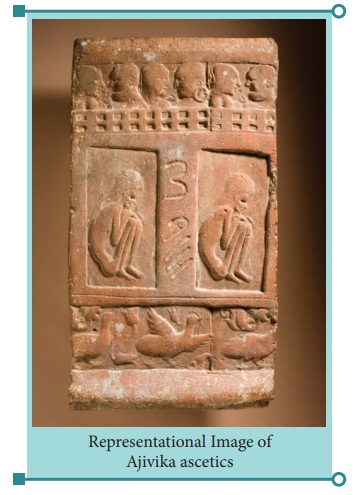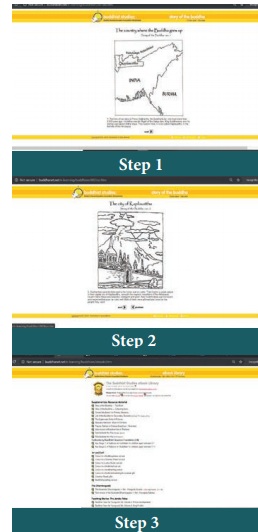Term 3 Unit 3 | History | 7th Social Science - Ajivika Philosophy in Tamil Nadu | 7th Social Science : History : Term 3 Unit 3 : Jainism, Buddhism and Ajivika Philosophy in Tamil Nadu
Chapter: 7th Social Science : History : Term 3 Unit 3 : Jainism, Buddhism and Ajivika Philosophy in Tamil Nadu
Ajivika Philosophy in Tamil Nadu
Ajivika
Philosophy in Tamil Nadu
Ajivika Philosophy
The Ajivikas believed in the doctrine
of karma, transmigration of the soul and determinism. The head of Ajivika
sect was Gosala Mankhaliputta. The Ajivikas practiced asceticism of a severe
type. The Ajivika religious order and school of philosophy is known from the
Vedic hymns, the Brahmanas, the Aryankas and other ancient
Sanskrit compilations and treatises of the pre-Jaina and pre-Buddhist age.
Gosala’s ideas live on in other religions, though no Ajivika literature has
survived.
Gosala was closely associated with
Mahavira for six years and then they parted company. The Mauryan emperor Asoka
and his grandson Dasaratha patronised the Ajivikas. After the collapse of the
Mauryan Empire, the sect declined in northern India, but had by then spread
into southern India where it continued to exist for many centuries.

Throughout
history, Ajivikas had to face persecution everywhere. Village communities under
Pallavas, Cholas and Hoysalas imposed special taxes on them. Despite such
obstacles, Ajivikas continued to have influence along the Palar river in the
modern states of Karnataka and Tamil Nadu (Vellore, Kanchipuram and Tiruvallur
districts) till about the 14th century. In the end, they seemed to have been
absorbed into Vaishnavism.
Summary
*
Sources and literature for study of Jainism are highlighted.
*
Presence of Jains in the Tamil country is examined.
*
Jain monuments and art in Tamizhakam, in particular Sittanavasal and
Kazhugumalai are illustrated.
*
The Jain contribution to education through ‘Palli’ is explained.
*
Buddhist teachings are analysed.
*
Buddhism in the Tamil country is explored.
*
Buddhist legacy in Tamizhakam is discussed.
*
The essence of Ajivika philosophy and its presence in Tamil Nadu is detailed.
References
1.
Glimpses of World Religions: Buddhism, Jaico, 2004).
2.
Henry Thomas, Dana Lee Thomas, Living Biographies of Great Religious Leaders,
Bharatiya Vidya Bhavan, 1996.
3.
Abraham Early, Gem in the Lotus, Penguin, 2002.
4.
P.C. Alexander, Buddhism in Kerala, Annamalai University, 1949.
5.
Times of India, 21 July 2014.
6.
The Hindu, 7 September 2014.
Glossary
1.
heterodox not conforming to orthodox
beliefs, especially religious ones, unorthodox பழமை
சாராத,
வழக்கத்திலுள்ள
மதக்கொள்கைககு
மாறான
2.
canon a rule, an accepted principle ஒரு
விதி,
பாது
ஒழுங்கு
3.
unanimous all sharing the same view ஒருமனதாக
4. ascetic monk, hermit துறவி,
சந்நியாசி
5.
deteriorate to grow worse சீர்கெடு,
மைாசமடை
6. vestiges
things left behind, remains, traces தடங்்கள,
அடையாளங்கள,
சுவடுகள்
7.
cavern a large deep underground cave
அடிநில
குகை
8.
hillock small hill, mound சிறு
குன்று
9. facade
the front of a building ககட்டத்தின் முககப்பு
10.
frescoes paintings done in water
colour on a wall or சுவரில் அல்லது
மேற்கூரையில்
11.mural a large picture painted on a wall
ceiling வரையப்படும்
ஓவியங்கள
சுவமராவியம்
12. impetus motivation, stimulus உத்வேககம்,
உந்துசகதி
13.
salvation saving from harm, ruin or
loss இரடசிப்பு,
முகதி,
விமைாசனம்
14.
sceptic (skeptic) someone who
habitually doubts accepted beliefs ஐயுறவுவாத,
சமய
ஐயுறவாளர்
15.
craving a strong desire அடக்கமுடியாத
ஆசை,
மிகு
விருப்பம்
16.
persecution unfair treatment of a
person or a group, especially because of their religious or political beliefs துன்புறுத்தல்,
அடககுமுறை
ICT
CORNER
BUDDHISM
To know and learn about the Buddhism through
this activity

PROCEDURE :
Step
1: Open the Browser and type the URL (or) Scan the QR Code.
Step
2: Story of Buddha page will appear on the screen.
Step
3: Click on the Image to know about the story of Buddha.
Step
4: Click on the ebook below the image to download the PDF.

Web URL:
http://www.buddhanet.net/e-learning/buddhism/storybuddha.htm
*Pictures
are indicative only
Related Topics